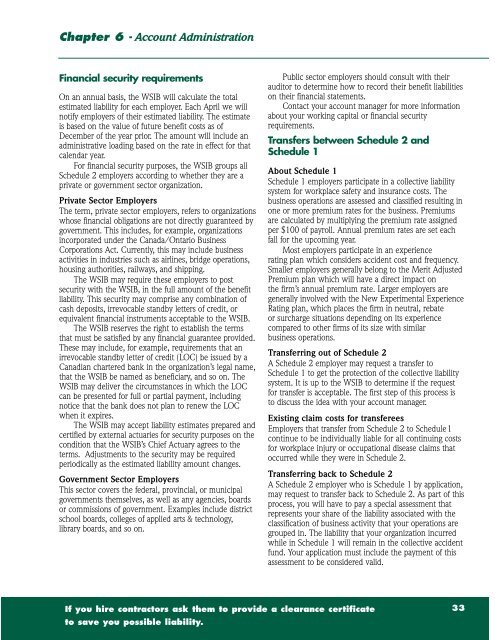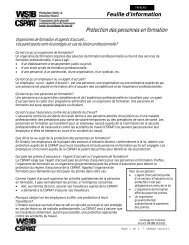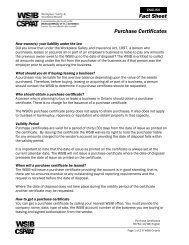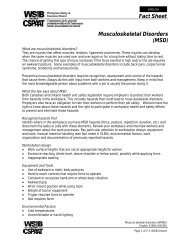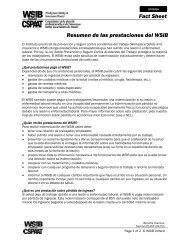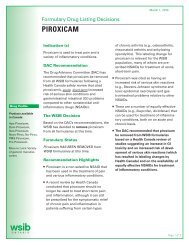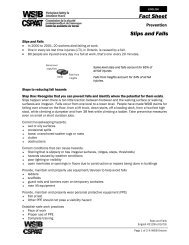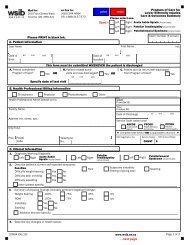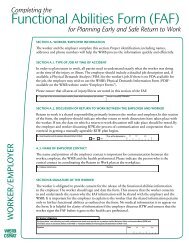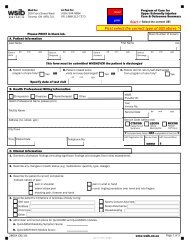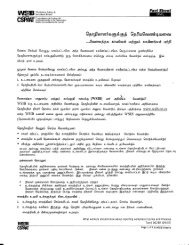Workplace Safety & Insurance Coverage - wsib
Workplace Safety & Insurance Coverage - wsib
Workplace Safety & Insurance Coverage - wsib
Create successful ePaper yourself
Turn your PDF publications into a flip-book with our unique Google optimized e-Paper software.
Chapter 6 -Account Administration<br />
Financial security requirements<br />
On an annual basis, the WSIB will calculate the total<br />
estimated liability for each employer. Each April we will<br />
notify employers of their estimated liability. The estimate<br />
is based on the value of future benefit costs as of<br />
December of the year prior. The amount will include an<br />
administrative loading based on the rate in effect for that<br />
calendar year.<br />
For financial security purposes, the WSIB groups all<br />
Schedule 2 employers according to whether they are a<br />
private or government sector organization.<br />
Private Sector Employers<br />
The term, private sector employers, refers to organizations<br />
whose financial obligations are not directly guaranteed by<br />
government. This includes, for example, organizations<br />
incorporated under the Canada/Ontario Business<br />
Corporations Act. Currently, this may include business<br />
activities in industries such as airlines, bridge operations,<br />
housing authorities, railways, and shipping.<br />
The WSIB may require these employers to post<br />
security with the WSIB, in the full amount of the benefit<br />
liability. This security may comprise any combination of<br />
cash deposits, irrevocable standby letters of credit, or<br />
equivalent financial instruments acceptable to the WSIB.<br />
The WSIB reserves the right to establish the terms<br />
that must be satisfied by any financial guarantee provided.<br />
These may include, for example, requirements that an<br />
irrevocable standby letter of credit (LOC) be issued by a<br />
Canadian chartered bank in the organization’s legal name,<br />
that the WSIB be named as beneficiary, and so on. The<br />
WSIB may deliver the circumstances in which the LOC<br />
can be presented for full or partial payment, including<br />
notice that the bank does not plan to renew the LOC<br />
when it expires.<br />
The WSIB may accept liability estimates prepared and<br />
certified by external actuaries for security purposes on the<br />
condition that the WSIB’s Chief Actuary agrees to the<br />
terms. Adjustments to the security may be required<br />
periodically as the estimated liability amount changes.<br />
Government Sector Employers<br />
This sector covers the federal, provincial, or municipal<br />
governments themselves, as well as any agencies, boards<br />
or commissions of government. Examples include district<br />
school boards, colleges of applied arts & technology,<br />
library boards, and so on.<br />
Public sector employers should consult with their<br />
auditor to determine how to record their benefit liabilities<br />
on their financial statements.<br />
Contact your account manager for more information<br />
about your working capital or financial security<br />
requirements.<br />
Transfers between Schedule 2 and<br />
Schedule 1<br />
About Schedule 1<br />
Schedule 1 employers participate in a collective liability<br />
system for workplace safety and insurance costs. The<br />
business operations are assessed and classified resulting in<br />
one or more premium rates for the business. Premiums<br />
are calculated by multiplying the premium rate assigned<br />
per $100 of payroll. Annual premium rates are set each<br />
fall for the upcoming year.<br />
Most employers participate in an experience<br />
rating plan which considers accident cost and frequency.<br />
Smaller employers generally belong to the Merit Adjusted<br />
Premium plan which will have a direct impact on<br />
the firm’s annual premium rate. Larger employers are<br />
generally involved with the New Experimental Experience<br />
Rating plan, which places the firm in neutral, rebate<br />
or surcharge situations depending on its experience<br />
compared to other firms of its size with similar<br />
business operations.<br />
Transferring out of Schedule 2<br />
A Schedule 2 employer may request a transfer to<br />
Schedule 1 to get the protection of the collective liability<br />
system. It is up to the WSIB to determine if the request<br />
for transfer is acceptable. The first step of this process is<br />
to discuss the idea with your account manager.<br />
Existing claim costs for transferees<br />
Employers that transfer from Schedule 2 to Schedule1<br />
continue to be individually liable for all continuing costs<br />
for workplace injury or occupational disease claims that<br />
occurred while they were in Schedule 2.<br />
Transferring back to Schedule 2<br />
A Schedule 2 employer who is Schedule 1 by application,<br />
may request to transfer back to Schedule 2. As part of this<br />
process, you will have to pay a special assessment that<br />
represents your share of the liability associated with the<br />
classification of business activity that your operations are<br />
grouped in. The liability that your organization incurred<br />
while in Schedule 1 will remain in the collective accident<br />
fund. Your application must include the payment of this<br />
assessment to be considered valid.<br />
If you hire contractors ask them to provide a clearance certificate<br />
to save you possible liability.<br />
33


